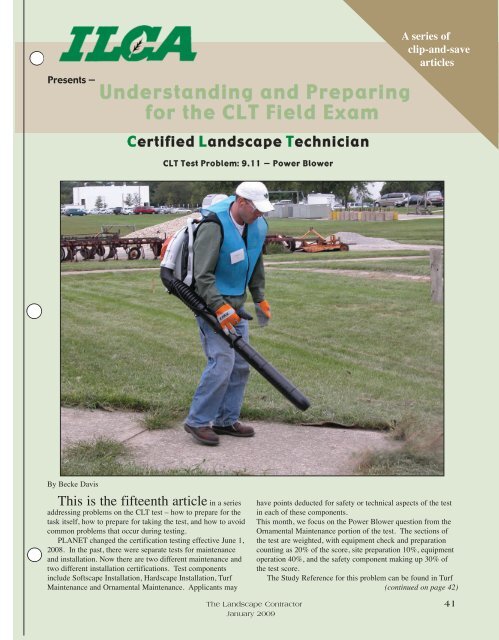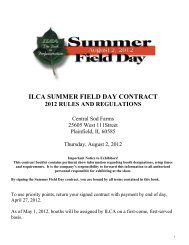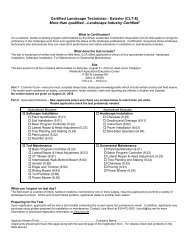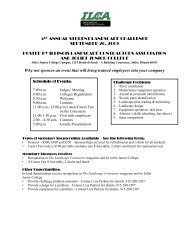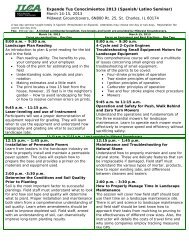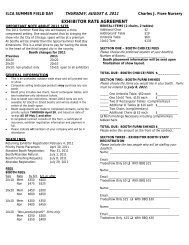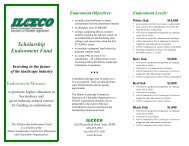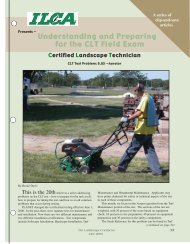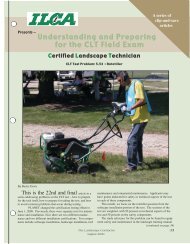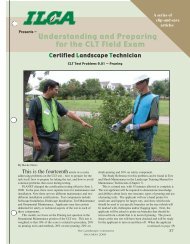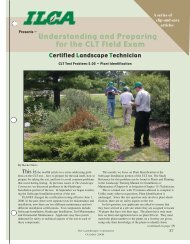Power Blower - Illinois Landscape Contractors Association
Power Blower - Illinois Landscape Contractors Association
Power Blower - Illinois Landscape Contractors Association
- No tags were found...
You also want an ePaper? Increase the reach of your titles
YUMPU automatically turns print PDFs into web optimized ePapers that Google loves.
Presents —<br />
U n d e r s t a n d i n g a n d P r e p a r i n g<br />
f o r t h e C L T F i e l d E x a m<br />
Certified <strong>Landscape</strong> Technician<br />
CLT Test Problem: 9.11 — <strong>Power</strong> <strong>Blower</strong><br />
A series of<br />
clip-and-save<br />
articles<br />
By Becke Davis<br />
This is the fifteenth article in a series<br />
addressing problems on the CLT test – how to prepare for the<br />
task itself, how to prepare for taking the test, and how to avoid<br />
common problems that occur during testing.<br />
PLANET changed the certification testing effective June 1,<br />
2008. In the past, there were separate tests for maintenance<br />
and installation. Now there are two different maintenance and<br />
two different installation certifications. Test components<br />
include Softscape Installation, Hardscape Installation, Turf<br />
Maintenance and Ornamental Maintenance. Applicants may<br />
have points deducted for safety or technical aspects of the test<br />
in each of these components.<br />
This month, we focus on the <strong>Power</strong> <strong>Blower</strong> question from the<br />
Ornamental Maintenance portion of the test. The sections of<br />
the test are weighted, with equipment check and preparation<br />
counting as 20% of the score, site preparation 10%, equipment<br />
operation 40%, and the safety component making up 30% of<br />
the test score.<br />
The Study Reference for this problem can be found in Turf<br />
(continued on page 42)<br />
The <strong>Landscape</strong> Contractor 41<br />
January 2009
C L T F i e l d E x a m P r e p<br />
(continued from page 41)<br />
Equipment Operation and Safety in the<br />
<strong>Landscape</strong> Training Manual for<br />
Maintenance Technicians (Chapter 8).<br />
This is a timed test, with 15 minutes<br />
allowed to complete it. The test applicant<br />
is sent to a<br />
work site<br />
where the turf<br />
area is bordered<br />
by an<br />
office, driveway<br />
and walkway,<br />
assuming<br />
that it is a<br />
warm, summer<br />
day. The office<br />
windows are<br />
open and vehicles<br />
are present<br />
in the driveway.<br />
Upon<br />
arriving at the<br />
site, the applicant<br />
will check<br />
and prepare the<br />
equipment for<br />
operation, identifying<br />
and<br />
removing any<br />
existing hazards<br />
prior to<br />
operating the<br />
blower. S/he<br />
will then start<br />
the machine<br />
and proceed to<br />
clean the driveway<br />
and walkway<br />
areas, as well as the turf area adjacent<br />
to the “office,” removing the debris<br />
from each of these areas. When this is<br />
completed, the applicant will clean the<br />
blower and prepare it for storage. The<br />
judge is to be considered a pedestrian,<br />
and the test applicant is asked to be<br />
careful to treat the judge as such.<br />
Armando Actis is the demo and<br />
product training manager for Pace, Inc.<br />
Although the company is based in<br />
Plymouth, MI, Actis works out of<br />
Joliet. He has been a CLT judge since<br />
moving to <strong>Illinois</strong> from New Jersey in<br />
2002. In that time, he has judged a<br />
number of small equipment categories,<br />
including power blower, string trimmer,<br />
edger, chain saw, tiller, aerator<br />
and concrete saw.<br />
“The biggest mistake for about 75<br />
percent of the applicants is forgetting<br />
to put on a disposable paper face<br />
mask,” he says. “This has been<br />
mandatory for about five years now.<br />
They might do everything else okay –<br />
they’ll put on the earplugs, the safety<br />
glasses, the gloves – but they forget the<br />
masks, and they’re right there in front<br />
of them.<br />
“When the applicants arrive at the<br />
test site, they approach the desk, go<br />
over the checklist, read the problem<br />
and then they’re okay to start. They<br />
pick up the safety equipment when they<br />
sign in – it’s not hidden, it’s right there<br />
by the sign-in,<br />
only inches<br />
away. When<br />
they collect their<br />
safety stuff,<br />
many just push<br />
the masks aside<br />
and put the rest<br />
of it on.”<br />
Actis stresses<br />
that the use<br />
of disposable<br />
face masks is<br />
nothing new in<br />
the landscape<br />
industry. “For<br />
use with concrete<br />
saws,<br />
where dust can<br />
get in the lungs,<br />
it’s been mandatory<br />
for 10 or 12<br />
years. For<br />
power blowers,<br />
it’s more recent,<br />
but still about<br />
five years. The<br />
masks aren’t<br />
just required for<br />
the CLT tests –<br />
OSHA and<br />
everyone else<br />
requires that masks be worn when<br />
blowing leaves or where dust, dirt or<br />
other particles can be inhaled.”<br />
With this test question, Actis<br />
explains, most of the mistakes are related<br />
to the safety component. “People<br />
will pick up the safety gloves and put<br />
them in their pocket – they won’t actually<br />
use them,” he says. “They’re not<br />
supposed to be in your pockets –<br />
they’re supposed to be on your hands.<br />
42 The <strong>Landscape</strong> Contractor<br />
January 2009
with the rest of the junk. Some<br />
won’t bother to pick up debris,<br />
things like rocks that you could<br />
cut yourself on. Instead of picking<br />
up things like a soda can, a<br />
piece of glass or a clump of grass,<br />
they’ll just push it aside. The<br />
judge is acting as a passer-by, and<br />
the test applicants are supposed to<br />
be trained to ask the person to<br />
move to one side, and then talk to<br />
them. It’s supposed to be like a<br />
time-out.”<br />
That about covers the mistakes,<br />
Actis says, emphasizing that close<br />
to 30 percent of those who fail do<br />
so because they forgot to wear the<br />
disposable mask. “If they forget<br />
the mask and screw up something<br />
small – boom! – they just failed<br />
the test,” he explains. “If they<br />
remember the mask, they can<br />
make a couple of small mistakes<br />
and still pass.”<br />
While reviewing the study<br />
guide and doing hands-on preparation<br />
is always recommended, for<br />
this test in particular, safety is key.<br />
Take all of the safety equipment<br />
provided and actually wear it.<br />
And whatever you do, don’t forget<br />
to put on the disposable paper<br />
mask.<br />
It’s the same with safety glasses; they’ll<br />
take them and put them on top of their<br />
heads. You’re supposed to put them<br />
over your eyes, not on your head!” It<br />
obviously frustrates Actis to see people<br />
make such obvious mistakes but, as he<br />
observes, “We’re not allowed to say<br />
anything until after the test.”<br />
According to Actis, the equipment<br />
check portion of the test doesn’t cause<br />
many problems. “Mostly, they know<br />
what to do. Normally, they pass the<br />
operations part of the test, although<br />
some will blow towards the judge<br />
instead of away. If the judge comes up,<br />
they should turn the blower on low or<br />
turn it off, and ask the judge to move<br />
away,” he explains.<br />
There are several common mistakes<br />
people make with site preparation,<br />
though. “Applicants are supposed to<br />
pick up any debris and put it in a pile<br />
The <strong>Landscape</strong> Contractor 43<br />
January 2009


